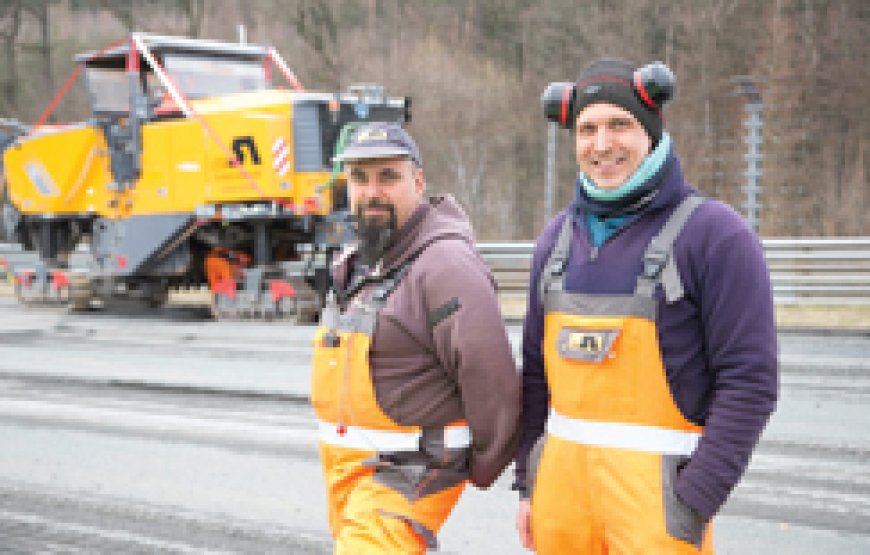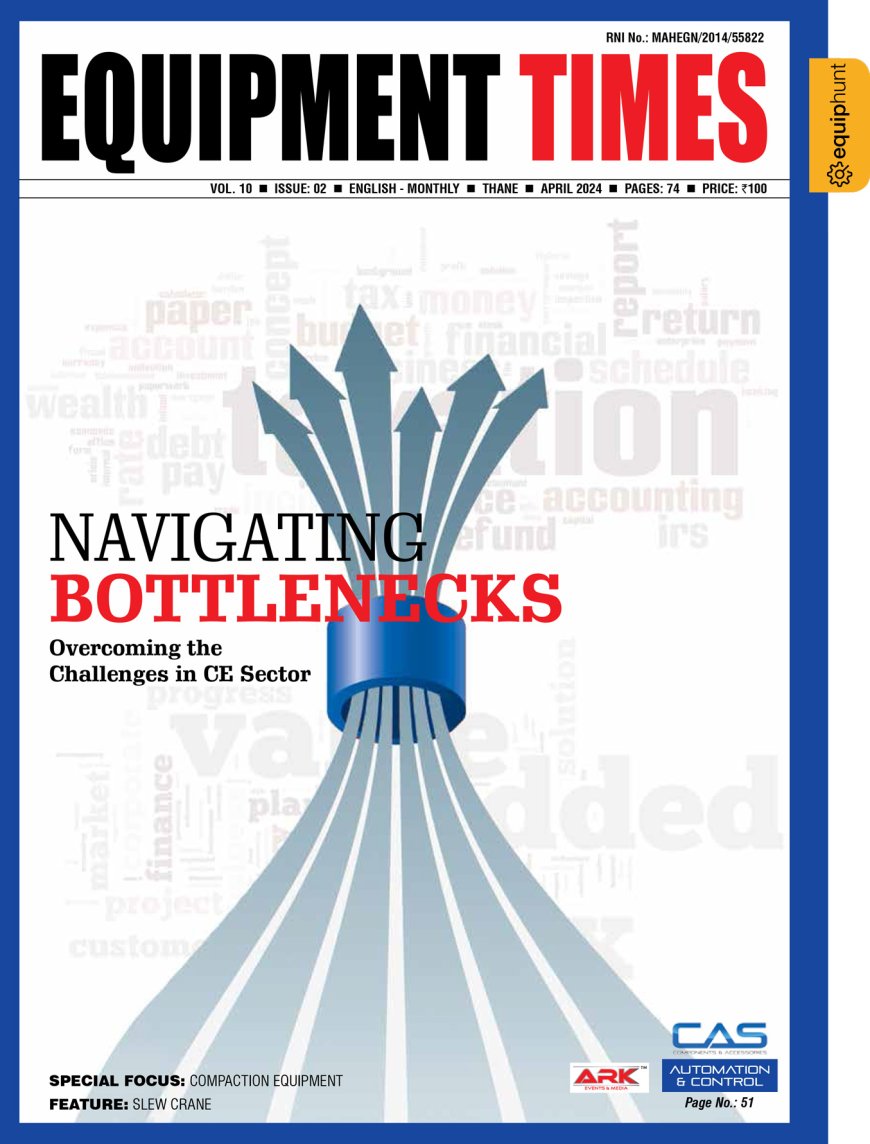A Fresh Grip at 90
Wirtgen milling machines, Vögele pavers and a Benninghoven mixing plants are rehabilitating the legendary Sachsenring race track in the Ore Mountains so that it continues to meet the requirements of the FIM (Fédération de Motocyclisme International) in the years to

Wirtgen milling machines, Vögele pavers and a Benninghoven mixing plants are rehabilitating the legendary Sachsenring race track in the Ore Mountains so that it continues to meet the requirements of the FIM (Fédération de Motocyclisme International) in the years to come.
The project entailed replacing the surface and binder courses. This demanding job was handled by plants and machinery of the Wirtgen Group. While Wirtgen cold milling machines created a level base true to line and level through precision milling, a mixing plant from Benninghoven and paving technology from Vögele ensured the high quality of the mix and the paving work.
Track Layout Based on Digital Data
Millimeter accuracy is paramount on a track where every thousandth of a second counts, which is why, when it was time to rehabilitate the pavement, the client took the opportunity to re-profile the track, too. The plan was to change the geometry of the track on selected bends – just the job for the Wirtgen W 200 and W 220 large milling machines.
 Maximum precision was a must during milling, as cold milling machines have a considerable influence on the quality of road rehabilitation works. This is especially true for race tracks, as the demands to be met during rehabilitation by far exceed those of normal road paving jobs. It was necessary to mill off the existing asphalt pavement to a depth of 8 cm. The call for tender specified 3D leveling for the re-profiling of several bends.
Maximum precision was a must during milling, as cold milling machines have a considerable influence on the quality of road rehabilitation works. This is especially true for race tracks, as the demands to be met during rehabilitation by far exceed those of normal road paving jobs. It was necessary to mill off the existing asphalt pavement to a depth of 8 cm. The call for tender specified 3D leveling for the re-profiling of several bends.
The milling service provider used the digital terrain model previously created by the client to feed the processed data for leveling into the cold milling machines via an interface. “This means that it’s no longer necessary to scan references on the ground. Instead, the machines receive their milling depth information via a total station that is set up next to the pavement surface which is to be milled. It automatically follows the cold milling machine with a range of up to 100 m”, explains Gerald Kluge, university-qualified engineer and Head of Milling Division at SAT. To ensure that the machine receives a continuous reference signal during 3D milling, the total station must be relocated roughly every 100 m and recalibrated at the new position. Two total stations were used at the Sachsenring race track, each alternately serving as a signal transmitter for the milling machine.
Precision Milling Machines
A tight schedule meant that the rehabilitation work had to be completed as quickly as possible. Both Wirtgen W 200 and W 220 high-performance milling machines not only met expectations with regard to the milling performance, but also with functions such as automatic machine alignment by means of PTS (Parallel To Surface).
During parallel alignment of the large milling machine with the pavement surface, the automatic function takes care of all the tasks the operator would otherwise have to carry out himself. Time-consuming corrections are no longer necessary. The Wirtgen LEVEL PRO leveling system should be mentioned in this context; it processed the digital data with great precision, delivering an even milled surface.
Evenness Requirements Met Reliably
In combination with the 3D leveling system, the Wirtgen large milling machines fulfilled the high evenness requirements of below 6 mm, measured across a width of 4 m. In addition, the grade of the milled surface was not permitted to deviate from the specifications of the digital terrain model by 8 mm at any point. This requirement was also met, as evidenced by control measurements made during milling and the verification with a rolling straight edge. The 2 large milling machines removed the surface and binder courses on the entire race track with an area of just over 50,000 m² in only four days. The average advance rate of the machine was 7 m/min. The cold milling machines were equipped with a milling drum featuring a tool spacing of LA 8 – another client specification to ensure optimum interlocking of the new asphalt binder course with the milled surface.
High Vögele Paving Quality
Following on from the precise preliminary work of the Wirtgen cold milling machines, the asphalt pavers from Vögele then took over. As with the milling, preparations for the asphalt paving were thorough: As specified in the paving plan, the paving widths and the exact tracks of the individual pavers for the entire section were defined in advance. Measuring 3.7 km in length when complete, the asphalt strip was to have no longitudinal joints with as few end-of-day stoppages as possible. That meant the team of pavers had to reach a minimum speed of 3 m/min on the straight. In fact, the three pavers were a little faster on the move: With a paving width of approx. 5 m and a rate of advance averaging 4 m/min, they laid down just over 2,500 t of asphalt in 16 hours.
These high demands were prompted by the wish to create an asphalt surface that is as even as possible and has a homogeneous consistency and condition over the entire track. One of the requirements was that the degree of density immediately behind the pavers was not to vary by more than 2% between the left and the right side of the paved strips – no simple task, given a 14 m-wide, very twisty track widening to up to 20 m in places. To avoid fluctuations caused by using different machines, it was also specified that identical pavers and screeds had to be used. The contractor, Strabag, opted for Vögele machines of type SUPER 1900-2 with AB 500 TP1 Extending Screeds.
In projects of this kind, two things are essential if the machines are to have the optimum settings: A test field must be built, and the screeds must be parameterized correctly. “Only if all screeds are coordinated with each other can we pave surfaces “hot to hot”, producing strips with the same requirement for subsequent compaction by rolling and no difference in height,” explains race track specialist Dr. Rainer Hart, who oversaw the job. For that reason, a test field 12 x 40 m in size was asphalted before paving actually began.
“When paving this test field, we make sure the mixing plant and the pavers are precisely coordinated under the conditions actually prevailing on site. That’s the only way we can pave the actual track perfectly with asphalt of the highest quality right from the first meter,” says Horst Henninghausen. And he ought to know: In recent years he has worked as a foreman in the construction of more than ten Formula 1 tracks. His invaluable expertise in construction supervision was channeled into the Sachsenring project.
Optimum Pre-compaction
To achieve optimum pre-compaction, all three pavers were fitted with a high compaction screed. The screed plate in the screeds is one of the critical components for optimum pre-compaction. “With the tamper stroke and speed set appropriately, the complete paver/screed system optimally processed the paving material,” reports Michael Hahmann, Group Manager at Strabag in the Zwickau region.
As well as the pre-compaction, Michael Hahmann and his team also kept a constant eye on the evenness. The requirement for the surface course was that the specified height could not deviate from the digital terrain
model by more than 3 mm. Another requirement was an evenness of 3 mm, measured using the 4 m bar. To deliver this, the two outer pavers used the Big Multiplex Ski for grade and slope control on both sides. The paver in the middle scanned the optimally leveled, freshly paved asphalt surfacing. Here too, the know-how of the specialists
paid off: the correct setting of the sensors on the Big Ski was a key factor in achieving the required evenness, particularly on the tight bends of the race track.
Service in the Project run-up
Another requirement in the call for tenders was that the pavers had to be inspected in the workshop immediately before the start of the work. This job was handled by the Wirtgen Group sales and service company Wirtgen Zwickau, which is located just a few kilometers away from the Sachsenring. “The thorough inspection and servicing of machines are as much a part of our workshop service as repairs,” explains Uwe Walter. “We like to get these jobs done swiftly so that the machines are available to the customer again as quickly as possible.” And the Zwickau team obviously did its work well: “The pavers have done a great job,” said Hahmann.
Asphalt by the Minute
The smooth completion of the paving work owed much to the supply of mix, which was scheduled down to the last minute: Each day, some 1,300 t was delivered from the Benninghoven TBA 3000 mixing plant at the Zwickau site to the race track on 15 trucks with an average round trip taking just under 2 hours. This enabled the client, in collaboration with plant operator Deutsche Asphalt, to supply each of the pavers continuously for 16 hours. The quality of the mix was a key concern. The mixing plant, for instance, had to use at least four screens to produce the mix for the surface course. In addition, at least five hot bins with filling level and temperature monitoring and an overflow were to be provided in order to ensure the purity of the fractions.
Carrying out a thorough check of the TBA 3000 prior to the start of the work, race track specialist Dr. Rainer Hart said: “With six screens, the Benninghoven plant in Zwickau is outstandingly well equipped. It also has everything else that we need for our high-performance asphalt.” He ought to know, given that he developed the formula.
Minimum Tolerances
The world-famous expert praised the high precision of the plant in the coordination process: “The batch mix reports indicate that the fluctuations are well within tolerances.” Consistency of quality is particularly relevant when building race tracks, because the leeway is considerably smaller than when building public roads. To give an example, the proportions by weight of the individual fractions in the surface course must not deviate from the specification by more than 3 – 1.5%.
Low-consumption Benninghoven Power Burner
The burner of the plant, which was erected in 2008, can – as is usual in Germany – run on coal dust and oil. “It’s extremely sparing on resources,” confirmed HeikoReinwardt, Plant Manager. He adds, “Benninghoven produces by far the most economical burner on the market.” Once a year the Deutsche asphalt team calls in a service engineer from Benninghoven to carry out service; and if anything crops up in the meantime, we just give them a call. Even remotely, Benninghoven answers the majority of questions fully and expertly.”
Just recently GeroKretzschmar, an expert in industrial measuring and control technology and one of the mixing plant specialists at Wirtgen Zwickau, installed a rotary blower in the plant to deliver the coal dust from the silo to the burner. With a rotary vane feeder, this customized solution from Benninghoven ensures the freely adjustable supply of coal dust at a feed pressure of at least 1 bar.
The electrically heated bitumen tanks also contribute to the economical yet convenient operation. “This form of heating is cost-efficient, and we are saving on the cost of separate oil handling,” says the team of the mixing plant.
Many years of racing fun lie ahead
Thanks to the pinpoint asphalt production, thorough planning and the premium machines of the Wirtgen Group, the contractor was able to meet the high requirements on the asphalt surfacing in every respect. The race track operators, racing drivers and motorsport fans should soon be able to look forward to the races.
Hits: 33














